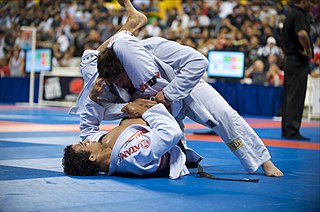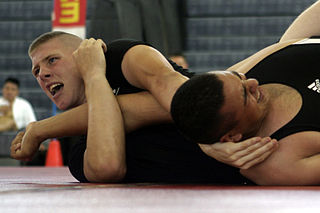
Grappling is a fighting technique based on throws, trips, sweeps, clinch fighting, ground fighting and submission holds.

Kickboxing is a full-contact combat sport and a form of boxing based on punching and kicking. The fight takes place in a boxing ring, normally with boxing gloves, mouth guards, shorts, and bare feet to favor the use of kicks. Kickboxing is practiced for self-defense, general fitness, or for competition. Some styles of kickboxing include: Full contact karate, Muay Thai, Japanese kickboxing, Lethwei, Sanda, and Savate.

Pankration was an unarmed combat sport introduced into the Greek Olympic Games in 648 BC. The athletes used boxing and wrestling techniques but also others, such as kicking, holds, joint-locks, and chokes on the ground, making it similar to modern mixed martial arts. The term comes from the Greek παγκράτιον, meaning 'all of power', from πᾶν (pan) 'all' and κράτος (kratos) 'strength, might, power'.

Brazilian jiu-jitsu is a self-defence martial art and combat sport based on grappling, ground fighting, and submission holds. BJJ focuses on taking ones opponent down to the ground, gaining a dominant position, and using a number of techniques to force them into submission via joint locks or chokeholds.

Schwingen, also known as Swiss wrestling and natively as Hosenlupf, is a style of folk wrestling native to Switzerland, more specifically the pre-alpine parts of German-speaking Switzerland. Wrestlers wear Schwingerhosen with belts that are used for taking holds. Throws and trips are common because the first person to pin his or her opponent's shoulders to the ground wins the bout.

Submission wrestling, also known as submission grappling, submission fighting or simply grappling, is a competitive martial art and combat sport that focuses on ground fighting and submission techniques. It is a hybrid discipline that incorporates elements of various grappling arts such as various wrestling styles, judo, and Brazilian jiu-jitsu. Submission wrestling is practiced both as a competitive sport and as a training method for self-defence and mixed martial arts (MMA).

Wrestling is a martial art and combat sport that involves grappling with an opponent and striving to obtain a position of advantage through different throws or techniques, within a given ruleset. Wrestling involves different grappling-type techniques such as clinch fighting, throws and takedowns, joint locks, pins, and other grappling holds. Many different wrestling techniques have been incorporated into martial arts, combat sports, and military systems. Wrestling is genuine competition; professional wrestling is athletic theatre.

Ssireum or Korean wrestling is a folk wrestling style and traditional national sport of Korea that began in the fourth century.

Arm wrestling is a sport with two opponents who face each other with their bent elbows placed on a table and hands firmly gripped, who then attempt to force the opponent's hand down to the table top. The sport is often casually used to demonstrate the stronger person between two or more people.

Gouren is a style of folk wrestling which has been established in Brittany for several centuries.

A grappling hold, commonly referred to simply as a hold that in Japanese is referred to as katame-waza, is any specific grappling, wrestling, judo, or other martial art grip that is applied to an opponent. Grappling holds are used principally to control the opponent and to advance in points or positioning. The holds may be categorized by their function, such as clinching, pinning, or submission, while others can be classified by their anatomical effect: chokehold, headlock, joint-lock, or compression lock. Multiple categories may be appropriate for some of these holds.

A folk wrestling style is any traditional style of wrestling, which may or may not be codified as a modern sport. Most cultures have developed regional forms of grappling.

Collar-and-elbow wrestling is a martial art and form of jacket wrestling native to Ireland. Historically it has also been practised in regions of the world with large Irish diaspora populations, such as the United States and Australia.
Scottish Backhold is a style of folk wrestling originating in Scotland. The wrestlers grip each other around the Chest and shoulders at the back, with the right hand under the opponent's left arm and left arm over. With the chin resting on the opposite right shoulder and an S-Grip hold. The bout is controlled by a central referee and two judge's all of equal standing. Falls are decided by a majority of three rule, with no conferring. When the referee is sure that both wrestlers have taken a firm grip, he shouts "HOLD" and the bout starts. Should either wrestler break his hold or touch the ground with any part of his body except the soles of their feet, he/ she loses. If both wrestlers hit the ground or mat at the same time a "Dog Fall" is declared and the fall is wrestled again immediately. There is no ground work and the bouts are usually best of five falls.
Jujutsu techniques include joint locks, chokeholds, strikes, grappling, throwing, and other self-defense techniques.
This article describes the rules of judo. The main sections of the article describe the rules that apply to any situation in which judo is practiced, and those rules which apply only in judo competitions.

Cumberland and Westmorland wrestling, more commonly known just as Cumberland Wrestling, is an ancient and well-practised tradition in the traditional English counties of Cumberland and Westmorland. It bears enough of a resemblance to Scottish Backhold, which is practised just north of the border, for them to be classed under the joint heading North Country style.
Narodno rvanje is a style of traditional wrestling in Serbia.

Barróg was a style of folk wrestling practiced in Ireland until the early 20th century. It was a type of backhold wrestling, similar to Scottish Backhold and Cumberland and Westmorland wrestling.
Cornish wrestling is an ancient martial art which later became the sport that is still practiced today.
















